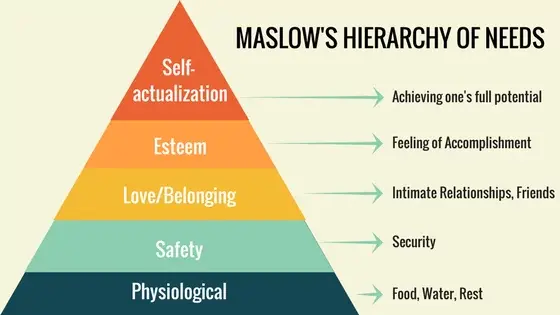Exploring Maslow's Hierarchy of Needs: A Simple Guide to Understanding Human Behaviours
- Paige Danniella MJ

- Jan 17, 2023
- 2 min read
Have you ever questioned why some individuals appear to have everything they desire, while others still struggle to meet their basic needs? The answer may lie in Maslow's Hierarchy of Needs, a theory proposed by psychologist Abraham Maslow in 1943. In this blog post, we will explore Maslow's Hierarchy of Needs and how it can help us understand human behaviours and motivations.

Maslow's Hierarchy of Needs is a pyramid-shaped model that consists of five levels of needs, starting from the most basic to the most complex. These five levels are:
Physiological Needs: These are our most basic needs that are necessary for survival, such as food, water, shelter and warmth. These needs must be met before a person can move on to the next level.
Safety and Security Needs: Once the physiological needs are met, a person will begin to focus on their safety and security needs. This comes in the form of a safe and stable environment, as well as protection from physical and/or emotional harm.
Love and Belonging: After safety and security needs are met, we can begin to focus on our need for love, affection and a sense of belonging. This includes the need for social connections, such as friends and family or the need for acceptance and validation from others.
Esteem: Once we feel safe and have a sense of belonging, we can then begin to shift our attention to the need for self-esteem and respect. Through a process of confidence building we can begin to understand our need to achieve our dreams and goals.
Self-Actualization: The highest level human need is self-actualization, which is our requirement to fulfill our potential and become the best versions of ourselves. This is where we pursue purpose with clarity and self awareness.
So, how does Maslow's Hierarchy of Needs Affect our Behaviour:
According to Maslow, our behaviour and motivations are driven by the level of needs that are currently unmet. For example, if our physiological needs are not being met, we will focus on obtaining food and shelter before we can shift our attention to any other needs.
Maslow's Hierarchy of Needs helps us to understand why individuals may be struggling. By recognising that these issues may stem from unmet physiological or safety needs, we can develop more effective solutions to address these issues.
Understanding this theory allows us to be more compassionate in our interactions with others and to provide the support and understanding that they need to fulfill their needs too. By having compassion for both others and self, we are able to understand and accept our own needs, which ultimately helps us to set healthy boundaries and move on up through the pyramid.
By understanding Maslow's Hierarchy of Needs, we can take a step toward creating a society that supports and nurtures the needs of all individuals, leading to a happier and healthier community.
Maslow's Hierarchy of Needs is a useful tool for understanding behaviour, by understanding the five levels of needs and how they affect us, we can better understand why people do the things they do.
If you found this helpful, let me know - get in contact by emailing PerceptionsbyPaige@gmail.com
*It is important to remember that this theory is not a one-size-fits-all model and that different people may prioritise different needs at different times.*












Comments